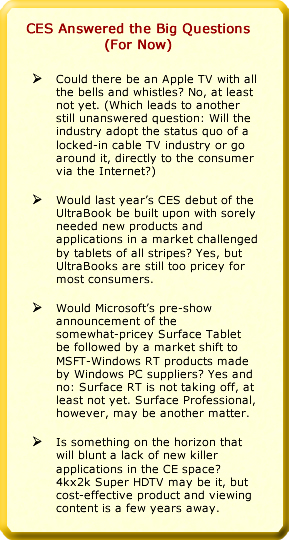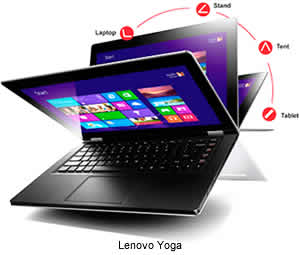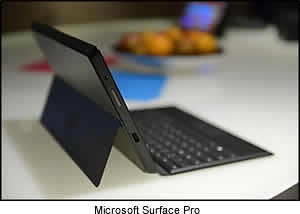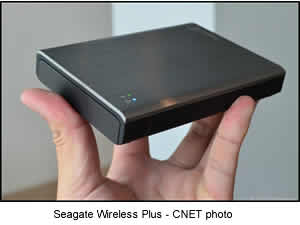Consumer Electronics in Transition

Consumer Electronics in Transition
The past decade has been a roller coaster ride, mostly up, for consumer electronics (CE). In many ways CE overshadowed business applications and helped drive unit volumes to new heights. Key developments behind this demand include:
- Adoption by — even love affairs with — a wide array of new electronics products by consumers
- Explosive growth in social media, wireless communications, entertainment applications, and products
- Blockbuster products such as iPods, iPhones, iPads, GPS devices, HDTV, and consumer-grade notebook computers that stretched and morphed into competing market segments
One could say this was the age of Apple, which re-emerged from the depths of the PC market to become the world’s most valuable corporation, until recent stock value losses. When the 2013 Consumer Electronics Show opened in Las Vegas last month, many were watching for the “next big thing” from Apple, as well as its many challengers. (See the sidebar for specifics.)
So, what does this all mean for the connector industry, which for years was moving away from low-cost consumer markets? The volume is there, pricing is tight, manufacturing is in Asia, and a PC market in transition is a point of concern.
Connector Impact in the Future CE Industry
Several major things are occurring that will impact connectors.
The venerable PC, at least the PC-AT/tower and its modular motherboard design, is in decline. Once the major connector market in PCs, it has begun to fade and is expected, by our forecasts, to drop up to 50% in volume the next five to seven years. Partially replacing it will be the All-in-One design popularized by the iMac and now touch-enabled with Windows 8. Most of the connector applications will remain in AIOs but in a more space-constrained package. There will be mixed results for memory and processor sockets; some will be replaced by direct-attach logic boards. SATA will remain but could see competition from faster small form-factor designs as SSD takes off. DDR3 will trend toward DDR4 in 2014-15. IO ports will remain, i.e.: USB 3.0, with HDMI and Display Port growing. The LCD interconnect application will remain as will PCIe and many other PC connector applications.
Notebook PCs will experience lower growth, instead of the year-to-year double-digit increases we’ve seen in the past. Reason? The iPad/tablet craze, which is strong in the consumer market, is impacting the PC market. Notebooks have been a key application for connectors, but the tablet market has absorbed a good deal of that all-important consumer demand. Some additional growth can be expected from the new UltraBook design, which will moderate in price and morph into the future notebook market.
 The jury is still out, in our minds, on convertible notebooks. These “flip” designs have allowed OEMs to showcase their design ingenuity and have provided new flexible interconnect applications. But unless they are thin and light like the Surface tablet or iPad, with a larger screen, they will not be mainstream computer products. Convertibles have a chance to become big, but until prices come down, the consumer market won’t take off. UltraBooks’ thin-and-light design with SSD/quick start and all-day battery life make them an attractive alternative to conventional notebooks with minimal performance compromise. Perhaps the biggest issues, to be minimized by emerging wireless Cloud computing, is in the number of IO ports.
The jury is still out, in our minds, on convertible notebooks. These “flip” designs have allowed OEMs to showcase their design ingenuity and have provided new flexible interconnect applications. But unless they are thin and light like the Surface tablet or iPad, with a larger screen, they will not be mainstream computer products. Convertibles have a chance to become big, but until prices come down, the consumer market won’t take off. UltraBooks’ thin-and-light design with SSD/quick start and all-day battery life make them an attractive alternative to conventional notebooks with minimal performance compromise. Perhaps the biggest issues, to be minimized by emerging wireless Cloud computing, is in the number of IO ports.
The tablet revolution will continue. Unlike PCs, which are designed as business-oriented content creation devices, tablets are primarily an information-viewing appliance. This appeals to consumers, who are less into Excel spreadsheets and more into email, photos, books, and movies. Tablet forecasts range from 300 to 500 million devices or more in five years, with connector content of five to 15 units/system, but few IO ports, because they are primarily wireless devices. The Surface has an interesting connection-oriented innovation: a magnetic pogo-pin connector for snapping the keyboard into place, somewhat similar to Apple’s Mag-Safe power port. It also has Windows 8 and Microsoft Office. The keyboard/Office design fills a void in tablet design and is part of Surface’s $600-and-up price point. The unit’s cost is offset by the inclusion of Microsoft Office.
Smartphones, with seven to 14 or more connectors per system, will continue to grow, surpassing cell phone volumes by 2015. FPC is big in smartphone applications, as are very small PCB connectors, card slots, and micro-USB. The Samsung Galaxy Note’s 5- to 6-inch LCDs verge on the tablet design, and we were surprised that the Apple iPhone 5 didn’t offer a bigger screen, because a smartphone is the ultimate handheld, perhaps soon-to-be wearable, information appliance.
Tablets and smartphone integration will have the highest levels of circuit integration, both monolithic and stacked die. We’re beginning to see tablets with screens and batteries with small, highly integrated logic boards, wireless radios, antennas, and one or two IO ports. In the past, circuit integration was always offset by increasing unit volume and the need to connect subsystems. System-in-Package and System-on-Chip will change some of that over the next five to seven years, yet increasing volume will offset any drop in connector content.
Cloud computing is coming of age. The future of PCs, tablets, and smartphones will be heavily interlaced with cloud applications. The Cloud is a transformative/disruptive innovation that threatens many vested interests, including the need for local software and applications. Key players will include Microsoft, Apple, Google, Amazon.com, Verizon, AT&T, and others. Some unknowns are quietly lurking in the background, planning massive storage farms. A ubiquitous cloud is particularly attractive for consumers because it is a form of artificial intelligence. You don’t have to be a computer expert to use it because it is always there and does all the heavy work for you.
So what are some of the best consumer product announcements we’ve already seen in 2013?
Microsoft Surface Pro
 Unlike the Surface RT, the Surface Pro is a full-fledged PC in a small super-light package. It sports a detachable keyboard, Intel Core i5 to i7 CPUs and makes few compromises in performance. At $899, it is in line with UltraBook pricing, is lower in weight (2 lbs), has USB 3.0, SATA/SSD, Bluetooth, MicroSD, and Mini-Display Port for external 1080P monitors. There are also a number of new convertible notebooks from HP, Dell, Lenovo, Asus, and others — even a 27” tablet from Lenovo.
Unlike the Surface RT, the Surface Pro is a full-fledged PC in a small super-light package. It sports a detachable keyboard, Intel Core i5 to i7 CPUs and makes few compromises in performance. At $899, it is in line with UltraBook pricing, is lower in weight (2 lbs), has USB 3.0, SATA/SSD, Bluetooth, MicroSD, and Mini-Display Port for external 1080P monitors. There are also a number of new convertible notebooks from HP, Dell, Lenovo, Asus, and others — even a 27” tablet from Lenovo.
YotaPhone
A Russian startup announced a dual-screen, gesture-controlled Android candy bar Smartphone. Its second screen is e-ink, which can be used to view documents, email, etc., and save on battery life. It will be sold as an unlocked phone, at first in Russia, starting this spring.
Lots of 4kx2k HDTVs
These were showcased by most of the major TV manufacturers, more as a future product direction than something in the immediate future. The problem is price, at $25,000 and up, and the lack of ultra-high res content. This is a logical trend for TV technology but one questions how soon this will take off, not to mention the bandwidth issues in transmitting 8 million pixel images.
Connected HDTV
The more logical trend in TV is WiFi and the looming battle over Web vs. cable. Will the two merge under the umbrellas of Comcast, Verizon, Time Warner, etc., or will an à la carte offering come from elsewhere, such as over the Internet or from Apple? Not featured at the show is a potential run by Intel into the set-top box business, featuring (we guess) Internet access, WiFi hotspot, and à la carte programming. Apple has not yet announced a new Apple TV, which could be in this vein. The biggest issue here will be the ability to get and deliver programming around (or through) the quasi-monopoly of the cable TV giants. We assume the latter will win because they own the pipe.
Many other products
 You can find tons of them in a web search, but none stand out as a truly transformative product innovation. Here is one that CNET liked: Seagate’s Wireless Plus 1TB hard drive. It comes with a battery, Internet hotspot capability, and USB 3.0. It allows streaming of movies and other content to multiple PCs, acting as a local cloud storage device.
You can find tons of them in a web search, but none stand out as a truly transformative product innovation. Here is one that CNET liked: Seagate’s Wireless Plus 1TB hard drive. It comes with a battery, Internet hotspot capability, and USB 3.0. It allows streaming of movies and other content to multiple PCs, acting as a local cloud storage device.
This device portends the future of cloud computing, which may be the next major transformation in the computer industry that will reach out into all corners of the marketplace, from e-commerce to automotive, telecom, computer, education, and home entertainment. The current giants, such as Microsoft and Intel, will have to adapt to this new reality. Fortunately for them, this will take time — perhaps the next decade — to be fully realized.
What may have been absent at this year’s CES, however, are the following market-shattering observations:
- Never before have so many new PC products been brought to market, even as the market is in serious transition. The impact of tablets, general economic stagnation, and mystery about which products (and companies) will be on top in five years create a backdrop of uncertainty as consumer and business markets merge via digital convergence of previously disparate technologies.
- The blockbuster product introductions of the past decade are now behind us, and Apple, which almost single-handedly transformed the CE industry, now has a major challenge ahead: How does it continue its breathtaking run of new products when, perhaps, “everything” has already been invented?
- Now former product innovations must carry the market into the future. HDTVs are evolving into Web-connected devices and moving toward ultra-high definition. Smartphones are getting bigger and smarter (but soon to be also smaller and wearable), and for many, a phone will be all they need to stay connected. Tablets are getting keyboards and notebooks are looking more like tablets. The iPods and digital cameras of the past are now integrated into the phone.
Bishop & Associates Inc. will soon be issuing a new report on the extended PC marketplace, from smartphones and tablets to UltraBooks and desktops. It shows continued growth in ultra-mobile products, slower growth in notebooks, and a significant decline in traditional motherboard/tower PC volumes over the next five to seven years. To keep your eye out for the report’s publication, visit Bishop & Associates online.
- Electric Vehicles Move into the Mainstream with New EV Battery Technologies - September 7, 2021
- The Dynamic Server Market Reflects Ongoing Innovation in Computing - June 1, 2021
- The Electronics Industry Starts to Ease Out of China - November 3, 2020

